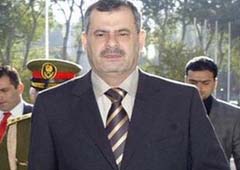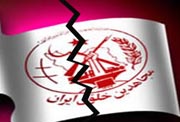An Iranian resistance group that has been living in exile in Iraq for decades is no longer a welcome guest in the country and may have no choice but to return to Iran, where some of its members fear they could be tortured and possibly executed as traitors.
return to Iran, where some of its members fear they could be tortured and possibly executed as traitors.
Some 3,400 members of the militant group the Mujahedin-e-Khalq — the People’s Mujahadeen of Iran, or MeK — have lived at Camp Ashraf, a 14-square-mile base north of Baghdad, since Saddam Hussein invited them there in 1986.
But the current Iraqi government, which took control of national security on New Year’s Day, has made it clear that it wants the MeK out. The government is unmoved by a sustained international campaign by the group that has included demonstrations and sit-ins in Washington and Geneva, Switzerland.
The MeK was founded in Iran in the 1960s, when it organized as a group opposed to the rule of the Shah. For more than two decades, it carried out a campaign of bombing and sabotage against the Iranian government, including the killing of U.S. citizens working in Iran in the 1970s, which led it to be designated an international terrorist organization by the U.S. State Department.
The MeK cooperated briefly with the clerical regime that overthrew the Shah in the Islamic Revolution, but then it turned against the nation’s new religious leadership, as well.
Despite its history of violence and its official designation as a terrorist group, some U.S. officials have been sympathetic toward the MeK because of the potential that it could be used as a card against Iran. But now that the Iraqi government wants the MeK to leave Iraq, the group’s designation as a terrorist organization is preventing other countries from offering its members a new home, and they fear they may have no choice but to return to Iran.
On Jan. 1, during a visit to Iran, Iraqi Prime Minister Nouri al-Maliki re-stated his government’s position:
"Iraq is determined to put an end to this organization because it is affecting relations between Iran and Iraq. This organization participated in many operations that harmed Iranian and Iraqi civilians under the Saddam regime."
Al-Maliki was referring to evidence that the MeK collaborated with the government of Saddam Hussein, particularly during the Kurdish uprising in 1991 when thousands of Kurds were massacred. The MeK denies involvement in the repression and cites supporting statements from, among others, Iraqi Foreign Minister Hoshyar Zebari.
Hopes had risen among MeK members and their overseas supporters that they had found a means of remaining in Iraq when the U.S. Embassy said on Dec. 27 that American forces would "maintain a presence at Camp Ashraf … to assist the government of Iraq in carrying out its assurances of humane treatment of the residents."
"It means the United States has recognized its responsibility to ensure the safety and security of our people in Ashraf," said Ali Safavi, an official of NCRI, political wing of the MeK.
But the U.S. government no longer considers MeK members in Iraq to have the protected-persons status the U.S. gave them in 2003, and is privately supportive of Iraqi government efforts to encourage the residents to leave.
The U.S. also doesn’t have the final say, as the Iraqi government assumed responsibility for all detainees on Jan. 1 under the terms of the Security Agreement.
The MeK once had the finest tank division in Iraq and harbored hopes of leading a resistance army back into Iran to topple the Tehran government. But it was disarmed in 2003 by Maj. Gen. Ray Odierno, then of the 4th Infantry Division, who put U.S. guards on the gate.
By then, the MeK had many enemies in Iraq as well as in Iran.
Nabaz Rasheed Ahmed, 61, a commander of the Kurdish Peshmerga fighters in 1991, said MeK forces attacked his battalion in Chiman, Kirkuk province, in 1991.
"Mujahideen fighters who were backed by Iraqi army helicopters and tanks attacked my battalion in March 29, 1991. They killed many of my Peshmergas and wounded a lot, including me," he said.
The military architect of that uprising was Neywshirwan Mustafa, 64, who now is chairman of the powerful Kurdish media group Wusha Corporation. When told that the MeK denied helping Saddam in his crackdown on the Kurds, Mustafa said:
"That is not true. They were working in cooperation with the Iraqi Army…. They attacked many bases belonging to the PUK.
"They occupied the road from Kanar to Kirkuk. They occupied a hospital in Kanar. They killed a doctor and many other civilian people. Saddam Hussein was protecting them in Iraq".
Abdullah Safir, 59, a Kurdish English teacher who lives in Kifri, in Kirkuk Province, says he was there when the MeK mobilized against his town in 1991.
"I knew they were opponents of the Iranian regime at the time. I did not expect them to intimidate people in a country in which they were guests, and to interfere in internal issues."
Safir recalled how the MeK shelled Kurdish towns "at random," took locals hostage, and in one incident attacked a busload of young people from Kifri, killing all 20. He remembers seeing some of the bodies when they were brought home and said that one or two had been run over by MeK tanks.
Joost Hiltermann of the International Crisis Group, which analyzes the causes of conflict, has also investigated the MeK’s role in Iraq.
"The MEK has yet to own up to its intimate relationship with the Saddam regime, which protected it and deployed it against its enemies when this served its purpose," Hiltermann said. "It thus acquired its reputation as the ruthless tool of a thuggish regime."
Shorsh Haji, a researcher on Kurdish issues who lives in the United Kingdom, escaped from Iraq after the 1991 uprising with many Iraqi secret police documents and worked with New York-based Human Rights Watch to analyze the content. He said the mukhabarat — a branch of Saddam’s intelligence service — wrote in their reports that the MeK "heroically resisted the rebels and traitors who wanted to occupy Kirkuk."
The intelligence the MeK had on Iran made them most useful to Saddam — and later, to the United States, Haji said. And that, he said, accounts for the protection the U.S. gave them at Camp Ashraf.
One MeK member told FOX News that the group gave the U.S. the names of "32,000 Iranian agents working inside Iraq." She also mentioned MeK’s purported role in revealing the extent of Iran’s nuclear weapons program, though subsequent reports support the view that Israel actually provided the information for the MeK to release.
Iraq has told the residents of Camp Ashraf that they must be gone by March of this year. It has promised they will not be forcibly repatriated to Iran, but it is not clear where else they could go.
Sources told FOX News that the Iranian government has a list of 50 "most wanted" MeK members, around 20 of whom are believed to live at the camp.
In recent years Iran has made much of a new policy of humanely "readmitting" former MeK members into Iranian society, with the help of a group of ex-members called the Nejat Society, which means "Rescue."
Behzad Saffari, legal adviser for the MeK, told FOX News: "Anyone who repents or remorses the past are welcomed by the Iranian regime and can be used against the MeK. They are a useful commodity. But anyone who goes back to Iran and still keeps the ideas of the MeK — they will be executed."
Approximately half of the residents of Camp Ashraf are under 30 years old, too young to have been part of the MeK’s fighting past.
But this may partly explain why the MeK has outlived its usefulness. A Western diplomat told FOX News: "There’s nothing we lose from Camp Ashraf except a huge headache and taxpayer dollars."
Qassim Khidhir Hamad contributed to this report
By Anita McNaught
http://www.foxnews.com/story/0,2933,479404,00.html



